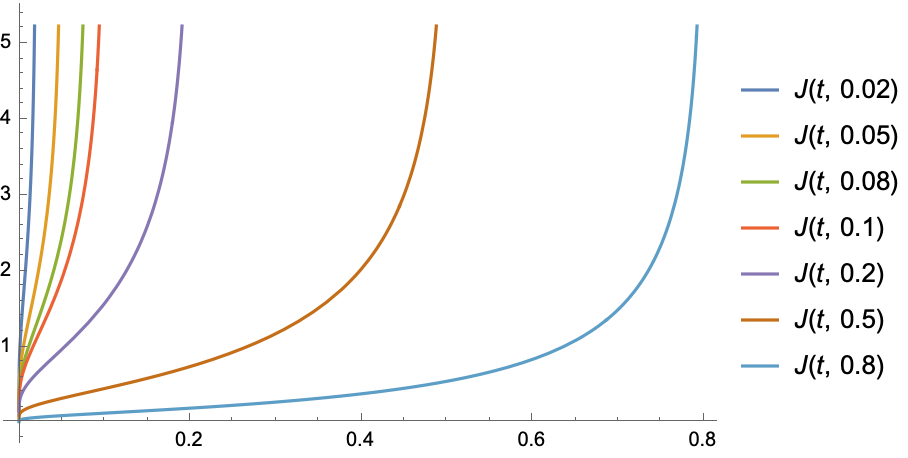
Earlier this year, Hammaad Adam communicated to me a rather entertaining puzzle regarding the cumulative distribution function (CDF) of a Standard Normal \(\mathcal{N}(0, 1)\). It initially defeated me, but a few months and a fresher mind later, I believe that I've managed to solve it. The puzzle is stated below.
Let \(\kappa \in (0, 1]\) and \(\Phi\) be the CDF of \(\mathcal{N}(0, 1)\). Prove that the function \[h(\tau) = \Phi^{-1}\left(\frac{\tau}{\kappa}\right) - \Phi^{-1}(\tau)\] is increasing in \(\tau \in (0, \kappa)\).
In this note, I show how this property about \(h\) is more generally true for a log-concave distribution with a differentiable probability density function (PDF).
Def. Concave function: A function \(f : \mathcal{S} \subseteq \mathbb{R} \to \mathbb{R}\) is concave if for any \(x, y \in \mathcal{S}\) and \(\lambda \in [0, 1]\), \(f(\lambda\cdot x + (1 - \lambda) \cdot y)) \geq \lambda \cdot f(x) + (1 - \lambda) \cdot f(y)\). Equivalently, when \(f\) is differentiable, \(f'\) is a decreasing function.
Def. Log-Concave distribution: A distribution with PDF \(\phi\) is said to be log-concave if \(\log\phi\) is a concave function.
For a distribution with a continuous PDF, we have the identity: \(\Phi(\Phi^{-1}(t)) = t\) for all \(t \in [0, 1]\). Differentiating both sides w.r.t. \(t\), we obtain that \([\Phi^{-1}]'(t) = \frac{1}{\Phi'(\Phi^{-1}(t))}\) for all \(t \in (0, 1)\). The derivative \(\Phi'\) is simply \(\phi\).
The derivative of \(h\) is hence given by \[h'(\tau) = \frac{1}{\kappa} \cdot \frac{1}{\phi\left(\Phi^{-1}\left(\frac{\tau}{\kappa}\right)\right)} - \frac{1}{\phi\left(\Phi^{-1}\left(\tau\right)\right)} \quad \forall~ \tau \in (0, \kappa)~.\] Our goal is to prove that \(h'(\tau) \geq 0\) for all \(\tau \in (0, \kappa)\), and for any \(\kappa \in (0, 1]\). Rearranging the terms in \(h'(\tau)\), this is equivalent to showing for all \(\tau \in (0, \kappa)\) that \begin{align} \phi(\Phi^{-1}(\tau)) &\geq \kappa \cdot \phi\left(\Phi^{-1}\left(\frac{\tau}{\kappa}\right)\right)~.& (\star) \end{align}
While the inverse CDF is undefined for \(0\), we have by definition of the CDF \(\Phi(t) = \int_{-\infty}^{t} \phi(t)\mathrm{d}t\). The support of the distribution is \(\mathcal{S} = \{x : \phi(x) > 0\}\) -- this is convex due to the log-concavity of \(\phi\). This suggests that an appropriate "value" of \(\Phi^{-1}(0)\) is the infimum of \(\mathcal{S}\), which is denoted by \(\mathcal{S}_{\inf}\). We adopt the convention that \(\log \phi(\mathcal{S}_{\inf}) = -\infty\), and this can also be jusitifed by the log-concavity of \(\phi\). All of this is to say that the inequality we intend to show \((\star)\) can be re-written as \begin{align*} \phi\left(\Phi^{-1}\left(\kappa \cdot \frac{\tau}{\kappa} + (1 - \kappa) \cdot 0\right)\right) &\geq \kappa \cdot \phi\left(\Phi^{-1}\left(\frac{\tau}{\kappa}\right)\right) + (1 - \kappa) \cdot \phi\left(\Phi^{-1}(0)\right)~.& (\star \star) \end{align*} Writing it in the manner above indicates that if \(\varphi := \phi \circ \Phi^{-1}\) is concave over \(\mathcal{S}\), then \((\star \star)\) and \((\star)\) are true, thus proving the assertion.
If \(\phi\) is additionally differentiable, then it is not too difficult to establish the concavity of \(\varphi\). To see this, we take the derivative of \(\varphi\): \begin{align*} \varphi'(x) &= \phi'\left(\Phi^{-1}(x)\right) \cdot [\Phi^{-1}]'\left(x\right) \\ &= \phi'\left(\Phi^{-1}(x)\right) \cdot \left\{\phi\left(\Phi^{-1}(x)\right)\right\}^{-1} \\ &= \left\{\left(\log \phi\right)' \circ \Phi^{-1}\right\}(x)~. \end{align*} Since \(\log \phi\) is concave, the derivative \(\left(\log \phi\right)'\) is a decreasing function, while \(\Phi^{-1}\) is an increasing function. The composition of a decreasing function and an increasing function results in a decreasing function, which implies that \(\varphi'\) is decreasing, and therefore \(\varphi\) is concave. But this begs the question: is this true when \(\phi\) is not necessarily differentiable, but still continuous?
In my original attempt, I tried using the definition of \(\phi\) for \(\mathcal{N}(0, 1)\) which is \(\phi(t) = \frac{1}{\sqrt{2\pi}} \exp\left(-\frac{t^{2}}{2}\right)\). Plugging this in \((\star)\) resulted in \[\left\{\Phi^{-1}\left(\frac{\tau}{\kappa}\right)\right\}^{2} - \left\{\Phi^{-1}\left(\tau\right)\right\}^{2} \geq 2\log \kappa ~,\] which oddly looks more complicated than the showing the monotonicity of \(h\). At this point, I gave up on a formally proving this after numerically verifying that this condition is indeed true for a variety of \(\kappa\). See the plot below of \(J(\tau; \kappa) = \left\{\Phi^{-1}\left(\frac{\tau}{\kappa}\right)\right\}^{2} - \left\{\Phi^{-1}\left(\tau\right)\right\}^{2} - 2\log \kappa\). The \(x\)-axis is \(\tau\).
